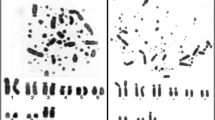Abstract
The chromosome variations found in the two European forms of Erinaceus have been studied by the use of 3H-Thymidine autoradiography in karyotype analyses and of meiotic preparations. The observations in Erinaceus are compared with the results of two forms of Hemiechinus. — The Western and the Eastern European hedgehogs (Erinaceus) have 48 chromosomes. Marked karyotypic differences corroborate the view that they represent different species, i.e. E. europaeus and E. roumanicus. Both possess large amounts of late labelling autosomal heterochromatin which corresponds to heteropyknotic non-pairing segments in meiosis and to large chromocenters in the interphase nuclei. — Obviously, the prominent variations of the chromosomes in E. europaeus and E. roumanicus concern the heterochromatic autosomal segments which probably represent genetically inactivated material. It is proposed that the gross karyotypic differences result from translocations, and possibly pericentric inversions, of heterochromatin and, therefore, are of lesser genetic importance. The genetically more effective changes in speciation, however, must mainly be caused by minor rearrangements or gene mutations. — H. auritus and H. megalotis have identical karyotypes (also with 48 chromosomes) and similar DNA-replication patterns. Larger heterochromatic segments are absent from mitotic and meiotic chromosomes. The lack of karyotype differences is in line with biometric data leading to consider H. megalotis as a subspecies of H. auritus. — It is conceivable that heterochromatinization as cytologic mechanism of karyotype evolution is not restricted to the European hedgehogs (Erinaceus). Other mammalian species displaying similar features must, however, be found in order to prove a more general importance of this principle.
Zusammenfassung
Die Vermutung, daß die Insektivoren in besonderem Maße Strukturvariationen der Chromosomen im Prozeß der Evolution der Arten widerspiegeln, war Ausgangspunkt dieser Arbeit.
Die Chromosomenuntersuchungen bei Erinaceus europaeus (Westigel) und E. roumanicus (Ostigel) sowie bei Hemiechinus auritus und H. megalous zeigten, daß alle vier Formen die gleiche Chromosomenzahl von 48 besitzen.
H. auritus und H. megalotis haben einen identischen Karyotyp und das gleiche DNS-Replikationsmuster. Der Befund kann als Beleg für die Annahme gelten, daß beide einer gemeinsamen Art zugehören und H. megalotis nur eine Großform von H. auritus darstellt.
Beide Arten der europäischen Igel (Erinaceus) besitzen, anders als Hemiechinus, große, spät replizierende und in der Meiose heteropyknotische Segmente, die als autosomales Heterochromatin aufgefaßt werden. Die sehr auffälligen Unterschiede der Karyotypen betreffen überwiegend diese heterochromatischen Segmente des Genoms, die möglicherweise besonders günstige Voraussetzungen für strukturelle Umschichtungen im Laufe der Evolution boten.
Vermutlich stellt das autosomale Heterochromatin einen genetisch inaktiven Anteil des Chromosomenkomplements dar. Seine Umlagerung im Laufe der Evolution ließ in cytologischer Hinsicht grobe Variationen des Genoms zu, ohne daß der genetisch aktive euchromatische Bestandteil des Genoms in gleichem Ausmaße betroffen wurde. Die beiden europäischen Igelarten sind dafür ein deutliches Beispiel.
Similar content being viewed by others
Literatur
Borgaonkar, D. S.: Insectivores. In: K. Benirschke (ed.), Comparative mammalian cytogenetics. Berlin-Heidelberg-New York: Springer 1969.
Bovey, R.: Les chromosomes des chiroptères et des insectivores. Rev. suisse Zool. 56, 371–459 (1949).
Citoler, P., u. A. Gropp: DNS-Replikation von autosomalem Heterochromatin. Exp. Cell Res. 54, 337–346 (1969).
Dyer, A. F.: Allocyclic segments of chromosomes and the structural heterozygosity that they reveal. Chromosoma (Berl.) 13, 545–576 (1963).
Ellerman, J. R., and T. C. S. Morrison-Scott: Checklist of Palaearctic and Indian mammals 1758–1946. London (Brit. Mus. Nat. Hist.), 2nd ed., 1966.
Geisler, M., and A. Gropp: Chromosome polymorphism in the European hedgehog Erinaceus europaeus (Insectivora). Nature (Lond.) 214, 396–397 (1967).
Gropp, A.: Cytologic mechanisms of karyotype evolution in Insectivores. Additional presentation of a case of Robertsonian variation in mice. In: K. Benirschke (ed.), Comparative mammalian cytogenetics, pp. 247–266. Berlin-Heidelberg-New York: Springer 1969.
-, u. P. Citoler: Vergleichende Untersuchungen über heterochromatische Strukturen des Interphasekerns. Anat. Anz. (im Druck).
—, and M. Geisler: Chromosomes in two subspecies of Erinaceus europaeus L., 1758 (Order Insectivora). Mamm. Chrom. Newsl. 22, 207 (1966).
Herter, K.: Die Biologie der Europäischen Igel. Monographien der Wildsäugetiere, Bd. V, 222 S. Leipzig: Schöps 1938.
John, B., and K. R. Lewis: The meiotic system. Protoplasmatologia, Bd. VI, F 1. Wien u. New York: Springer 1965.
—: The chromosome complement. Protoplasmatologia. Bd. VI, A. Wien u. New York: Springer 1968.
Kang, Y. S., and Y. J. Kim: Studies on chromosomes of the Korean mammals. I. Karyotypes of squirrel and others. Zoologica (Seoul) 2, 1 (1963). Unzugänglich, zit. nach D. S. Borgaonkar (1969).
Král, B.: Karyological analysis of two European species of the genus Erinaceus. Zoologické Listy 16, 239–252 (1967).
Kratochvíl, J.: Zur Frage der Verbreitung des Igels (Erinaceus) in der ČSSR. Zoologické Listy 15, 291–304 (1966).
Linnert, G.: Die Struktur der Pachytänchromosomen in Euchromatin und Heterochromatin und ihre Auswirkung auf die Chiasmabildung bei Salvia-Arten. Chromosoma (Berl.) 7, 90–128 (1955).
Mayr, E.: Animal species and evolution. Cambridge, Mass.: Harvard University Press 1963.
Meylan, A.: Données nouvelles sur les chromosomes des Insectivores européens (Mamm.). Rev. suisse Zool. 73, 548–558 (1966).
Niethammer, J: Die Säugetiere Afghanistans (Teil II): Insectivora, Rodentia, Lagomorpha. Science, Quart. J. (Fac. of Science, Kabul-University), p. 18–41 (Aug. 1965).
- Zur Taxonomie der Ohrenigel in Afghanistan (Gattung Hemiechinus). Z. Säugetierk. (im Druck).
Ohno, S.: Sex chromosomes and sex-linked genes. Monogr. on Endocrinol., vol. I. Berlin-Heidelberg-New York: Springer 1967.
Swanson, C. P.: Cytology and cytogenetics. London: Macmillan & Co Ltd. 1963.
Taylor, K. M., D. A. Hungerford, R. L. Snyder, and F. A. Ulmer Jr.: Uniformity of karyotype in the Camelidae. Cytogenetics 7, 8–15 (1968).
Wettstein, O. v.: Die Säugerwelt der Ägäis, nebst einer Revision des Rassenkreises von Erinaceus europaeus. Ann. Naturhist. Mus. Wien 52, 245–278 (1941).
White, M. J. D.: Models of speciation. Science 159, 1065–1070 (1968).
Wurster, D. H., and K. Benirschke: Comparative cytogenetic studies in the order Carnivora. Chromosoma (Berl.) 24, 336–382 (1968).
Author information
Authors and Affiliations
Additional information
Herrn Prof. Dr. H. Hamperl zum 70. Geburtstag.
Mit Mitteln des Landesamts für Forschung Nordrhein-Westfalen und der Deutschen Forschungsgemeinschaft.
Rights and permissions
About this article
Cite this article
Gropp, A., Citoler, P. & Geisler, M. Karyotypvariation und Heterochromatinmuster bei Igeln (Erinaceus und Hemiechinus). Chromosoma 27, 288–307 (1969). https://doi.org/10.1007/BF00326166
Received:
Accepted:
Issue Date:
DOI: https://doi.org/10.1007/BF00326166




